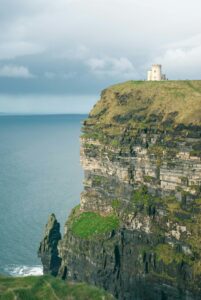Cliffs of Moher
The Cliffs of Moher stand as one of Ireland’s most renowned and magnificent natural wonders, attracting more than a million tourists annually. Scaling steeply from the Atlantic Sea on the nation’s western shoreline, these cliffs extend for roughly 14 kilometers (8.7 miles) and present stunning vistas from above, with their peak soaring to 214 meters (702 feet).
A trip to the Cliffs of Moher is essential for anyone venturing through Ireland, providing not just stunning scenery but also a chance to immerse oneself in the untouched, natural splendor of the outdoors.
History of Cliffs of Moher:
 The Moher Cliffs were created over 300 million years ago in the Upper Carboniferous era, when rivers laid down deposits of siltstone, shale, and sandstone into the ocean.
The Moher Cliffs were created over 300 million years ago in the Upper Carboniferous era, when rivers laid down deposits of siltstone, shale, and sandstone into the ocean.
Over time, these deposits were compacted and eventually shaped the cliffs that exist today. Their impressive height and harsh beauty have inspired poets, artists, and travelers for ages.
The name “Moher” is derived from a destroyed promontory fort known as Mothar or Moher Tower, which once stood at Hag’s Head. Constructed in the early medieval era, this fort was probably built for defensive purposes against enemies.
During the Napoleonic Wars in the early 1800s, a signal tower was erected at Hag’s Head as part of a network of coastal watchtowers. Although the fort is no longer present, its name continues to be associated with the cliffs.
In recent times, the Cliffs of Moher have become globally recognized due to their appearances in numerous movies and TV series. They were the backdrop for the “Cliffs of Insanity” in The Princess Bride and were also used in Harry Potter and the Half-Blood Prince, further cementing their status as an iconic landmark.
How to Reach Cliffs of Moher:
There are multiple routes to reach the Cliffs of Moher, depending on where you begin your journey and how you prefer to travel.
Starting in Dublin: The Cliffs of Moher are about 3.5 hours away by car from Dublin. You have the option to rent a vehicle and drive along the M6 and M18 highways for a picturesque and direct path. Another choice is to arrange a day trip, which frequently includes pit stops at other nearby sites such as Galway or the Burren National Park.
Heading from Galway: Galway is the closest major city, a 90-minute drive away by car. You can travel along the N67 coastal route for breathtaking views of the surrounding countryside, or opt for a bus service that operates frequently from Galway to the Cliffs of Moher Visitor Centre.
Public Transportation: Bus Éireann offers daily bus services from Dublin, Galway, and other close-by places like Limerick and Ennis. This mode of transport is budget-friendly, although it might take a bit more time than driving.
For the Active: If you’re up for an adventure, there are paths for walking and cycling that lead to the cliffs. The Burren Way is a popular choice for walkers, providing a deep dive into the Burren scenery.
Things to Do
 The Burren National Park: A short journey from the cliffs, the Burren boasts a distinctive karst terrain, characterized by limestone pavements, uncommon wildflowers, and ancient archaeological sites. It’s an ideal destination for nature walks, cave explorations, and uncovering historical treasures such as Poulnabrone Dolmen.
The Burren National Park: A short journey from the cliffs, the Burren boasts a distinctive karst terrain, characterized by limestone pavements, uncommon wildflowers, and ancient archaeological sites. It’s an ideal destination for nature walks, cave explorations, and uncovering historical treasures such as Poulnabrone Dolmen.
Doolin Village: Often referred to as the entrance to the Cliffs of Moher, Doolin is celebrated for its authentic Irish music. Visit one of the local pubs, like Gus O’Connor’s, to enjoy live performances, traditional Irish dishes, and a cozy, friendly environment.
Aillwee Cave and Birds of Prey Centre: Nestled in the Burren, Aillwee Cave provides guided excursions through a remarkable underground network of caverns, waterfalls, and stalactites. The Birds of Prey Centre in the area features live shows of falcons, hawks, and owls.
Kilfenora: Often described as the “City of the Crosses,” Kilfenora is the site of the Kilfenora Cathedral, which was built in the 12th century. The village is also famous for its impressive high cross, The Doorty Cross.
Lahinch Beach: Located just 15 minutes from the Cliffs of Moher, Lahinch is a favored destination for surfing, swimming, and leisurely walks along the beach. The town also offers a stunning golf course and a variety of beachfront cafes and restaurants.
Top Attractions in Cliffs of Moher:
The Moher Cliffs Visitor Centre This eco-conscious visitor hub, recognized for its excellence, is nestled into the hillside, offering a plethora of details on the cliffs’ geological makeup, historical significance, and diverse fauna. The displays are engaging, providing a more profound insight into the formation of the cliffs over 300 million years ago. The visitor center features a café, a gift shop, and a multimedia exhibit titled “The Ledge,” which illustrates the cliffs’ appearance in various weather scenarios.
O’Brien’s Tower Constructed in 1835 by Cornelius O’Brien, this tower stands as the pinnacle of the cliffs. A nominal fee is required to ascend to the summit, where visitors can relish sweeping vistas of the Aran Islands, Galway Bay, and the Twelve Bens mountain range in Connemara.
The Cliff Walk This trail stretches for miles along the cliff’s edge, presenting constantly shifting vistas of the cliffs and coastline. For a more immersive journey, hikers can complete the Cliffs of Moher Coastal Walk, which spans from Doolin to Liscannor, covering a distance of about 20 kilometers (12.4 miles).
Hag’s Head Located at the cliffs’ southernmost point, Hag’s Head provides a more secluded, less crowded experience. Named after a rock formation that appears to resemble a woman’s head, this area sees fewer visitors yet offers equally breathtaking views and is an excellent place to fully appreciate the length of the cliffs.
The Puffin Colony The cliffs of Moher are a sanctuary for over 30,000 birds, including puffins, razorbills, guillemots, and kittiwakes. Puffins, in particular, nest along the cliffs during their breeding season (April to July). Bird enthusiasts should bring binoculars for a closer observation of these intriguing seabirds.
The Aran Islands Visible from the cliffs, the Aran Islands are a favored destination for day trips. Ferries are available from the nearby town of Doolin, enabling visitors to explore the islands’ rugged landscapes, ancient forts, and rich cultural heritage. Inishmore, the largest island, is home to the prehistoric fort of Dún Aonghasa.
Boat Tours For a unique viewpoint, boat tours from Doolin offer a water-based perspective of the cliffs. These tours give a sense of the cliffs’ grandeur, as they rise dramatically above the sea. It’s also possible to spot dolphins and seals during the excursion.
Best Time to Visit Cliffs of Moher:
The Cliffs of Moher can be visited year-round, but the experience can vary depending on the time of year.
 Spring (March to May): This is one of the best times to visit, as the weather is mild and the crowds are smaller. Flowers start to bloom, adding color to the landscape.
Spring (March to May): This is one of the best times to visit, as the weather is mild and the crowds are smaller. Flowers start to bloom, adding color to the landscape.
Summer (June to August): The summer months bring the best weather, but they also bring the largest crowds. If you visit in summer, try to arrive early in the morning or late in the afternoon to avoid the busiest times.
Autumn (September to November): Autumn offers fewer tourists and stunning golden hues in the surrounding fields. However, the weather can start to become more unpredictable, with increased rain and wind.
Winter (December to February): The cliffs are quiet during the winter, but the weather can be harsh. If you don’t mind braving the cold and possible rain, winter offers a peaceful and moody atmosphere, with far fewer visitors.
Safety Tips:
The Cliffs of Moher are breathtaking, yet they pose risks if you don’t take the necessary safety measures. Here are a few key safety guidelines to remember:
Stay on the marked routes: It might be hard to resist the urge to venture closer to the edge for an enhanced perspective, but the cliffs are composed of unstable loose rocks. It’s safer to stay behind the protective barriers and stick to the clearly indicated paths.
Keep an eye on the forecast: The climate at the cliffs can shift quickly, with frequent gusty winds and showers. Wear clothing in multiple layers, pack rain gear, and be cautious of strong breezes, particularly close to the cliff’s edge.
Wear solid shoes: The terrain can be rough, and wet conditions from mud or rain can make the paths slick. Opt for comfortable yet robust footwear, particularly if you intend to hike or explore beyond the primary viewing spots.
Show respect for nature: The cliffs are a habitat for various bird species, including puffins. It’s thrilling to observe wildlife, but it’s important not to disturb any creatures or their nests.
Credits:
- Image by DejaVu Designs on Freepik
- Photo by Clare on Unsplash
- Photo by Alina Rossoshanska : https://www.pexels.com/photo/woman-standing-by-cliffs-of-moher-23644398/
Conclusion:
Exploring the Cliffs of Moher is an experience that is rare and displays the unadulterated splendor of Ireland’s western shoreline. Whether you’re a passionate walker, a lover of the outdoors, or just seeking to immerse yourself in the breathtaking scenery, the cliffs have something to cater to all interests.
By taking the necessary steps and ensuring safety measures, your visit to the Cliffs of Moher will be a memorable highlight of your Irish adventure.